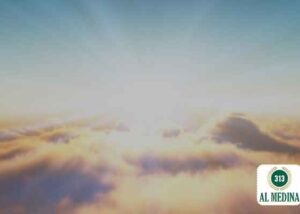What is in the Dome of the Rock Masjid? What is the significance of that rock?
Quran
Hadith
Islamic Text
بِسْمِ اللَّهِ الرَّحْمَنِ الرَّحِيمِ
In the Name of Allah Most Merciful Most Kind
Short Answer
There is a large rock at the center of the Dome of the Rock Masjid. This Rock was the Qiblah (prayer direction) for the Prophet ﷺ and the Muslims before it was changed to the Ka’bah. The Rock and the Masjid are within the Aqsa area. Therefore, it is venerated as part of Masjid al-Aqsa.
Explanation
الْبَرَاءَ، يَقُولُ: صَلَّيْنَا مَعَ رَسُولِ اللهِ صَلَّى اللهُ عَلَيْهِ وَسَلَّمَ نَحْوَ بَيْتِ الْمَقْدِسِ سِتَّةَ عَشَرَ شَهْرًا، أَوْ سَبْعَةَ عَشَرَ شَهْرًا، ثُمَّ صُرِفْنَا نَحْوَ الْكَعْبَةِ
(Sayidina) al-Bara’ narrated: We prayed with the Messenger of Allah ﷺ facing Bait al-Maqdis for sixteen months or seventeen months. Then we were diverted towards the Ka’bah. (Sahih Muslim 525 – 12).
It is not al-Aqsa
It is important to recognise that the Dome of the Rock Masjid is not al-Masjid al-Aqsa. Many Muslims are mistaken regarding this issue. They believe al-Aqsa is the Dome of the Rock Masjid. However, the entire area is Masjid al-Aqsa and the Dome of the Rock is simply a part of it. See our related answer and images for further clarification and proof.
The Rock was the Qiblah
As seen in the Hadith above, Masjid al-Aqsa used to be the Qiblah prior to it changing to the Holy Ka’bah in Makkah Sharif. Many senior scholars of Ahl al-Sunnah have mentioned that the Qiblah was the Rock itself. This has also been attributed to the great Sahabi Sayidina Abdullah bin Abbas.
قَالَ ابْنُ جُرَيْج: وَقَالَ ابْنُ عَبَّاس: كَانَ النَّبِيّ صَلَّى اللَّهُ عَلَيْهِ وَسَلَّمَ يَسْتَقْبِلُ صَخْرَةَ بَيْتِ الْمَقْدِسِ، فَأَوَّلُ آيَةٍ نسخت مِنَ الْقُرْآنِ: الْقِبْلَةُ. (التاريخ الكبير)
Ibn Jurayj narrated that Ibn Abbas said: The Prophet ﷺ was facing the Rock of Jerusalem. The first verse abrogated from the Qur’an was the Qiblah. (Imam Ibn Abi Khaythmah, al-Tarekh al-Kabeer).
حَجَّاجٍ عَنِ ابْنِ جُرَيْجٍ قَالَ قَالَ ابْنُ عَبَّاسٍ كَانَ النَّبِيُّ صَلَّى اللَّهُ عَلَيْهِ وَسَلَّمَ يَسْتَقْبِلُ صَخْرَةَ بَيْتِ الْمَقْدِسِ قَبْلَ قُدُومِهِ صَلَّى اللَّهُ عَلَيْهِ وَسَلَّمَ ثَلَاثَ حِجَجٍ وَصَلَّى بَعْدَ قُدُومِهِ سِتَّةَ عَشَرَ شَهْرًا ثُمَّ وَجَّهَهُ اللَّهُ تَبَارَكَ وَتَعَالَى إِلَى الْبَيْتِ الْحَرَامِ. (التمهيد لما في الموطأ من المعاني والأسانيد)
Hajjaj narrated from Ibn Jurayj, who said: Ibn Abbas (May Allah Most High be pleased with them both) said: The Prophet ﷺ used to face the Rock of Jerusalem for three years before he arrived (in Madinah). He ﷺ prayed (facing it) for sixteen months after his arrival. Thereafter, Allah Most High directed him to the Sacred House (Ka’bah). (Imam Ibn Abd al-Barr, al-Tamheed).
وَأخرج أَبُو دَاوُد فِي ناسخه عَن ابْن عَبَّاس قَالَ: أول مَا نسخ من الْقُرْآن الْقبْلَة وَذَلِكَ أَن مُحَمَّدًا كَانَ يسْتَقْبل صَخْرَة بَيت الْمُقَدّس وَهِي قبْلَة الْيَهُود فَاسْتَقْبلهَا سَبْعَة عشر شهرا. (الدر المنثور)
Abu Dawud narrated in his Nasikh, from (Sayidina) Ibn Abbas, who said: The first thing that was abrogated from the Qur’an was the Qiblah. Muhammad ﷺ used to face the Rock of Jerusalem, which is the Qiblah of the Jews. He faced it for seventeen months. (Imam Jalal al-Deen al-Sayuti, al-Durr al-Manthur).
Senior Tabieen
The fact that the rock itself was the Qiblah has also been attributed to major Tabieen. Amongst them Imam Hasan al-Basri and Ikrimah.
حَدَّثَنَا ابْنُ حُمَيْدٍ، قَالَ: ثنا يَحْيَى بْنُ وَاضِحٍ أَبُو تُمَيْلَةَ، قَالَ: ثنا الْحُسَيْنُ بْنُ وَاقِدٍ، عَنْ عِكْرِمَةَ، وَعَنْ يَزِيدَ النَّحْوِيِّ، عَنْ عِكْرِمَةَ، وَالْحَسَنِ الْبَصْرِيِّ، قَالَا: ” أَوَّلُ مَا نُسِخَ مِنَ الْقُرْآنِ الْقِبْلَةُ، وَذَلِكَ أَنَّ النَّبِيَّ صَلَّى اللهُ عَلَيْهِ وَسَلَّمَ كَانَ يَسْتَقْبِلُ صَخْرَةَ بَيْتِ الْمَقْدِسِ وَهِيَ قِبْلَةُ الْيَهُودِ، فَاسْتَقْبَلَهَا النَّبِيُّ صَلَّى اللهُ عَلَيْهِ وَسَلَّمَ سَبْعَةَ عَشَرَ شَهْرًا. (جامع البيان عن تأويل آي القرآن)
Ibn Humayd narrated to us from Yahya bin Wadih Abu Tamailah who narrated to us from al-Hussain bin Waqid from Ikrimah, from Yazid al-Nahwi, from Ikrimah and al-Hasan al-Basri, who both said: The first thing that was abrogated from the Quran was the Qiblah. The Prophet ﷺ used to face the Rock of Jerusalem, which was the Qiblah of the Jews. The Prophet ﷺ faced it for seventeen months. (Tafseer al-Tabari, Imam Abu Jafar al-Tabari).
Sunni Scholars
As well as the above narrations, we find many early and later leading Sunni Imams mention that the Qiblah was the rock itself. Although others do not specify and simply say that Masjid al-Aqsa was the Qiblah.
فَأَوَّلُ مَا نُسِخَ مِنَ الْقُرْآنِ نُسِخَتِ الْقِبْلَةُ؛ كَانَ مُحَمَّدٌ رَسُولُ اللَّهِ صَلَّى اللَّهُ عَلَيْهِ وَسَلَّمَ يَسْتَقْبِلُ صَخْرَةَ بَيْتِ الْمَقْدِسِ، وَهِيَ قِبْلَةُ الْيَهُودِ، سَبْعَةَ عَشَرَ شَهْرًا. (الجامع لابن وهب)
The first thing that was abrogated from the Quran was the Qiblah (prayer direction). Muhammad, the Messenger of Allah ﷺ used to face the Rock of Jerusalem for seventeen months. It was the Qibla of the Jewish people. (Imam Abdullah bin Wahb, al-Jami).
وَهِيَ الصَّخْرَةُ فَلِهَذَا كَانَتْ قِبْلَةَ الْأَنْبِيَاءِ بَعْدَهُ إِلَى زَمَانِ رَسُولِ اللَّهِ صَلَّى اللَّهُ عَلَيْهِ وَسَلَّمَ وَقَدْ صَلَّى إِلَيْهَا رَسُولُ اللَّهِ صَلَّى اللَّهُ عَلَيْهِ وَسَلَّمَ قَبْلَ الْهِجْرَةِ. (البداية والنهاية)
It was the Rock. It was the Qiblah of the Prophets after him until the time of the Messenger of Allah ﷺ. Indeed, the Messenger of Allah ﷺ prayed towards it before the migration. (Imam Abu al-Fidaa, al-Bidayah wa al-Nihaayah).
Many false narrations
The Nusoos (texts) above establish a tradition of considering the rock specifically to be the Qiblah. However, do we have other virtues specific to the rock itself? Some virtues have been narrated, but scholars warn against them being fabrications. Therefore, one should be careful and not narrate specific virtues without checking the evidence and authenticity.
وكل حَدِيثٍ فِي الصَّخْرَةِ فَهُوَ كَذِبٌ مُفْتَرًى وَالْقَدَمُ الَّذِي فِيهَا كَذِبٌ مَوْضُوعٌ مِمَّا عَمِلَتْهُ أَيْدِي الْمُزَوِّرِينَ. (المنار المنيف في الصحيح والضعيف)
And every Hadith about the Rock is a fabrication and a lie. The footprint that is within it is a lie. A fabrication invented by the hands of the forgers. (Imam Ibn Qayim al-Jowziyah, al-Manar).
وما يذكره بعض الجهال: أن هناك أثر قدم النبي – صلى الله عليه وسلم -، وأثر عمامته أو غير ذلك: فكله كذب. (تحفة الراكع والساجد بأحكام المساجد)
What some ignorant people mention: that there is a footprint of the Prophet ﷺ and a trace of his turban and other such matters, they are all lies. (Imam Abu Bakr bin Zayd al-Hanbali, Tuhfatu al-Raaki).
It is not superior
The rock within the Dome of the Rock Masjid is to be respected as part of Masjid al-Aqsa. The entirety of Masjid al-Aqsa is to be respected and considered blessed, the rock falls within that. However, it was not attributed specific virtue by the Salaf (early Muslims), as seen in the Nass below.
وأما أهل العلم من الصحابة والتابعين؛ فلم يكونوا يعظِّمون الصخرة؛ فإنها كانت قِبْلة ثمَّ نُسخت – كما أن يوم السبت كان عيدًا في شريعة موسى عليه السلام ثمَّ نسخ في شريعة محمَّد – صلى الله عليه وسلم – بيوم الجمعة، فليس للمسلمين أن يخصّوا يوم السبت ويوم الأحد بعبادة – كما يفعله اليهود والنصارى، وكذلك الصخرة؛ إنما يعظمها اليهود وبعض النصارى.
As for the people of knowledge among the Sahabah and Tabieen, they did not venerate the rock. It was once a Qiblah and then it was abrogated. Just as Saturday was a venerated day (Eid) in the law of Moses (peace be upon him) and then it was abrogated in the law of Muhammad ﷺ with Friday. It is not for Muslims to single out Saturday and Sunday for worship, as the Jews and Christians do. Likewise, the Rock. Rather the Jews and some Christians venerate it. (Imam Abu Bakr bin Zayd al-Hanbali, Tuhfatu al-Raaki).
Who built the dome
In the era of the Khulafaa al-Rashideen (rightly guided Caliphs) there was no structure over the rock. Rather it was uncovered. The Dome of the Rock Masjid was built to cover and honour the rock in the Umayyad era. The Caliph (Khalifah) Abd al-Malik bin Marwan built it during his conflict with Sayidina Abdullah bin Zubayr.
وقد كانت الصخرة مكشوفة في خلافة: أبي بكر، وعمر، وعثمان، وعليّ، ومعاوية، ويزيد بن معاوية، ومروان، ولكن؛ لما أخذ عبد الملك بن مروان الشام ووقع بينه وبين ابن الزبير الفتنة كان الناس يحجون فيجتمعون بابن الزبير، فأراد عبد الملك أن يصرف الناس عن ابن الزبير، فبنى لهم القبة على الصخرة، وكساها في الشتاء والصيف؛ ليرغب الناس في زيارة بيت المقدس، ويصّدهم بذلك عن ابن الزبير. (تحفة الراكع والساجد بأحكام المساجد)
The Rock was exposed during the caliphate of Abu Bakr, Umar, Uthman, Ali, Muawiyah, Yazid bin Muawiyah, and Marwan. However, when Abd al-Malik bin Marwan took control of the Levant (Sham) and unrest occurred between him and Ibn al-Zubayr, people would meet with Ibn Zubayr at Hajj. So, Abd al-Malik wanted to distance people from Ibn al-Zubayr. Thus, he built for them the dome over the rock. He covered it in winter and summer, to entice people to visit Jerusalem, and deter them from Ibn al-Zubayr. (Imam Abu Bakr bin Zayd al-Hanbali, Tuhfatu al-Raaki).
Summary
The rock within the Dome of the Rock Masjid is respected by Muslims since it is part of Masjid al-Aqsa. However, early Muslims did not consider it to be more specifically virtuous. It may be correct to say that the rock itself was the Qiblah prior to it being changed to the Holy Ka’bah. Beyond that, very little is soundly narrated regarding the virtue of the rock itself or the Dome of the Rock Masjid. Rather the narrations are generic, encompassing the entirety of al-Masjid al-Aqsa.
And Allah Most High Knows Best.
–Answered by Shaykh Noorud-deen Rashid (16.01.24)



